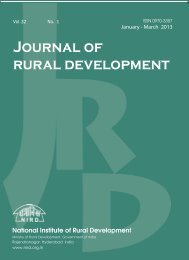October - December 2012 - National Institute of Rural Development
October - December 2012 - National Institute of Rural Development
October - December 2012 - National Institute of Rural Development
- No tags were found...
Create successful ePaper yourself
Turn your PDF publications into a flip-book with our unique Google optimized e-Paper software.
Social Mobilisation, Savings Habit and Access to Credit for the Poor ... 505Table 4 : (Contd.)(1) (2) (3) (4) (5) (6) (7) (8) (9)V Monthly Household IncomeBPL Family 49930 63 60404 67 28049 79 138383 6815000-25000 15058 19 22539 25 5681 16 43278 2125000-35000 3170 04 4508 05 1065 03 8743 0435000-50000 793 01 1803 02 355 01 2951 01> 50000 10303 13 902 01 355 01 11560 06Total 79254 100 90155 100 35505 100 204914 100VI OccupationAgriculture 34872 44 27047 30 13847 39 75765 37Agriculture Labour 21399 27 29751 33 11007 31 62156 30Construction Labour 11096 14 20736 23 8166 23 39997 20Business 7925 10 9917 11 1775 05 19618 10Service 2378 03 1803 02 710 02 4891 02Others 1585 02 902 01 0 00 2487 01Total 79254 100 90155 100 35505 100 204914 100Source : Field survey, 2008.members literate; while in Ganjam andGajapati districts almost 70 per cent <strong>of</strong> themembers are illiterate.Occupation : A major share <strong>of</strong> the SHGmembers, 37 per cent are engaged inagriculture; and nearly 30 per cent areagriculture labourers. Construction labourersconstitute 20 per cent; the rest are engagedin micro-enterprises (10 per cent), service(2 per cent) and other occupation (1 percent). Distribution <strong>of</strong> members based onoccupation is almost similar in all districts withlittle variation.Income : The income level <strong>of</strong> the SHGmembers shows that a majority <strong>of</strong> the SHGmembers (68 per cent) belong to BPL familywith monthly income less than `15000,followed by the income category <strong>of</strong> `15000-25000 (21 per cent) and 25001-3500 (4 percent). Data reveal that nearly 80 per cent <strong>of</strong>the SHG members in Gajapati district belongto BPL families. Based on monthly familyincome, members in Ganjam district arebetter <strong>of</strong>f compared to Gajapati and Puridistricts, with nearly 25 per cent belongingto a monthly income bracket <strong>of</strong> `15000-25000. Data reveal that SHGs in the districtslargely covered the poorest <strong>of</strong> the poor. It isalso found that non-poor are also included inthe groups but in less proportion, less than 6per cent <strong>of</strong> the total members.Savings Mobilisation Through SHGsOne <strong>of</strong> the characteristic features <strong>of</strong> theSHG movement in the country is theJournal <strong>of</strong> <strong>Rural</strong> <strong>Development</strong>, Vol. 31, No. 4, <strong>October</strong> - <strong>December</strong> : <strong>2012</strong>

















